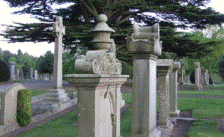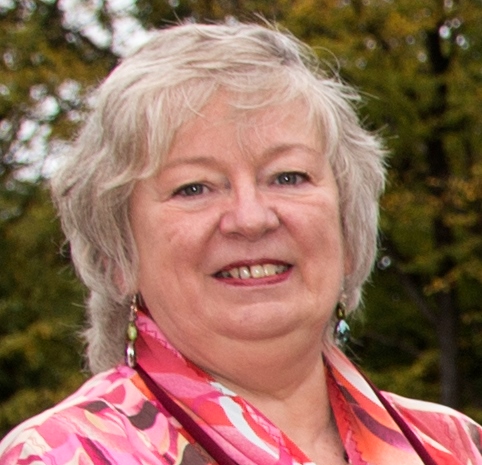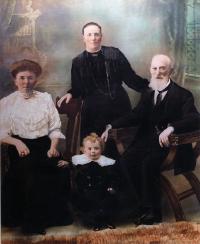- Birth*: Margaret Guthrie Alexander was born in 1870 at Drury, Takaka, New Zealand,
 .1,2
.1,2 - She was the daughter of Thomas Fraser Alexander contractor and Isabel McLean.
- (Bride) Marriage*: Margaret Guthrie Alexander married John Broadfoot in 1906.1,2
- (Deceased) Death*: Margaret Guthrie Alexander died in 1937 or 1938 at New Zealand,
 .1,2
.1,2 - Name-Married: Her married name was Broadfoot.2
- Married Name: As of 1906, her married name was Broadfoot.
- (Officiating Clergy) Marriage: She officiated at the marriage of Edward Henry Gear blacksmith and Margaret Guthrie Kidd on Tuesday, 10 August 1909 at residence of William Kidd, Millerton, Buller, New Zealand
 ; Henry was a 22 year-old bachelor & blacksmith born in Westport and residing in Millerton. Margaret was an 18 year-old spinster with no listed profession, born in Brunnerton and residing in Millerton. Married by certificate. Both signed their names. Marriage witnesses: James BROWN (storekeeper at Millerton), Myrtle KENNEDY (domestic duties) & William KIDD (Margaret’s father).3,2,1
; Henry was a 22 year-old bachelor & blacksmith born in Westport and residing in Millerton. Margaret was an 18 year-old spinster with no listed profession, born in Brunnerton and residing in Millerton. Married by certificate. Both signed their names. Marriage witnesses: James BROWN (storekeeper at Millerton), Myrtle KENNEDY (domestic duties) & William KIDD (Margaret’s father).3,2,1 August 9th 1909, Millerton, New Zealand. Wedding of Margaret Guthrie Kidd and Edward Henry Gear.
August 9th 1909, Millerton, New Zealand. Wedding of Margaret Guthrie Kidd and Edward Henry Gear.
Wedding party L-R : William Esau Kidd (with unknown best man seated in front), Isabella Kidd aged 20, Margaret Guthrie Kidd, bride aged 18, Edward Henry Gear, groom aged 22, Elizabeth Ann McQueen Kidd aged 11, Ann McQueen Kidd, mother of the bride aged 42, on her knee Fred Fox aged 2, Frances Fox nee Kidd aged 22, Margaret Guthrie Broadfoot, sister of the mother of the bride aged 39, Thomas Alexander aged 84, Jack Broadfoot holding his son Johnny, Thomas Alexander Kidd aged 21, Albert Kidd aged 15 seated on ground. Unfortunately the father of the bride, William Kidd, was standing at the extreme left hand side, but the photographer had his thumb over the lens and William Kidd was blotted out! - (Witness) Note for Web: Margaret Guthrie Alexander and Isabel McLean, George Alexander, Margaret Guthrie, Alexander Alexander, James Alexander, George Alexander, George Alexander, Ann McQueen Alexander and William Kidd were mentioned with Thomas Fraser Alexander contractor and Margaret Duff. Thomas allegedly left home when young because he didn't want to be a farmer and his father was very strict and hard on him. The fifth of six children, he may well have discussed with his four brothers the idea of travelling to Australia's goldfields. In the end, three of the Alexander sons left Scotland, never to return. Thomas' older brothers Alexander and James were to die in Victoria.
According to his death certificate, Thomas married three times but it doesn't quite match up. It's stated he married first at age 23, second at age 30, wives unknown. It does not mention his third marriage at age 33. Death certificates are the least reliable as the recipient is not there to verify the information. We do know that on 8 June 1855 in Condie, Forgandenny, Perthshire, Scotland, he married Margaret DUFF, daughter of William DUFF and Mary SCOBIE, and both were aged 25.
On 5 April 1856, Thomas and Margaret had a son George born in Forgandenny. On the birth certificate, Thomas's occupation was 'contractor'.
In June 1857, Thomas and Margaret sailed as unassisted immigrants into Victoria, Australia aboard the 'Red Jacket'. They both gave their ages as 27. Their son George would've been just over a year old but he doesn't show on the passenger list. Also on this ship was James Alexander aged 31, Thomas' brother.
Sadly, Margaret was to die three years later in 1860. With his father probably toiling in the goldfields all day, we can only wonder who minded young George after his mother died. This was also the year Thomas' mother died back in Scotland.
Two years later Thomas was struck by a further catastrophe with the death of five year-old George early in 1862, not long before his sixth birthday.
Knowing that his second son, also named George, was born in Australia, we can only surmise that Thomas met Isabel Mclean in Victoria. A passenger list exists with an Isabella Mclean sailing into Victoria aboard the 'Monica' in March 1859. Her age is stated as 33, which is about right. Though born as Isabel, she was known as Isabella.
Isabella might have known the Alexanders before Margaret died. After Margaret's death she might have looked after young George.
In 1862 or 1863 Thomas and Isabella had their first child George in Sandhurst (now Bendigo*). Following the Scottish custom, they named their first son after Thomas' father. * The name 'Bendigo' was used to describe the diggings along the Bendigo Creek until 18 January 1853 when Governor La Trobe named the township Sandhurst. In 1891 after a voters' poll, the name Bendigo was reinstated (F Cusack, Bendigo: A history, Heinemann, Melbourne,pp. 67 &188).
Maybe staying in Australia held too many sad memories for Thomas. Within eighteen months of his first son's death the family had immigrated to New Zealand.
Thomas and Isabella were married in the house of the officiating minister/registrar Benjamin Drake on Don Street, Invercargill on 22 September 1863. Two more children were born in New Zealand: Ann at Stafford, Hokitika, and Margaret at Takaka.
In the mid-1870s the Greymouth Coal Company had let a contract to sink a new main shaft to a mine; unfortunately the newspaper article doesn't name the mine. Striking trouble at 27 feet, the contractors threw in the contract and a new contract was let to Thomas at eight pound per foot. According to the 'Grey River Argus' of 20 June 1876, Thomas had sunk the shaft 216 feet and work was progressing well at about 10 feet per week.
Thomas and Isabel lived in Cromwell at the time of the Otago gold rush, before moving to Stafford (where Ann was born) and later Drury. Nothing more is known of the family until they lived in Brunnerton where Thomas was manager of the Brunner Coalmine.
The 'Grey River Argus' of 16 December 1881 reported on a meeting at the Volunteer Hall about the proposed East and West Coast Railway. It was resolved that the best information and data available should be prepared and presented to the Commissioners about to visit the West Coast, the Commissioners having been appointed by the Christchurch Chamber of Commerce. To this end a committee was to be elected to carry out the resolution and receive the Commissioners on their arrival in Greymouth. The duties of the committee were in the capacity of affording information and practical assistance in respect to the line, as well as greeting the Commissioners. Manager of the Coal Pit Heath mine at the time, Thomas was elected to the committee.
In 1882 The Working Miners' Gold-mining Company was registered and Thomas bought 500 shares.
In December 1883 Thomas wrote a letter defending a dentist who had operated on one of his daughters.
Thomas was manager of the Coal Pit Heath Company mine in 1883 till at least 1886 and was jointly responsible for a luncheon for visiting dignitary Sir William Francis Drummond Jervois, 'Governor and Commander-in-Chief in and over Her Majesty's Colony of New Zealand and its Dependencies' on 5 February 1886 when Sir William visited the Brunner and Coal Pit Heath mines, the two leading mines in the district.
On the Electoral Roll for Hokitika in 1885, Thomas was listed as living in Taylorville, Brunner.
In 1886 Thomas bought three sections.
Thomas got his name in the newspaper when he was clouted on the head by a piece of coal. While putting in a prop in the Brunner mine, a large piece of coal fell from the roof, hitting him on the head and severely wounding his scalp. According to the 'Evening Post' of 6 October 1887 he went to Greymouth to get the wound stitched.
Along with an article in the 'West Coast Times', Hokitika's local newspaper the 'Grey River Argus' dated 25 November 1887 listed Thomas among the candidates standing for election to the first Brunner Council. The elections were held in November 1887. Thomas was unsuccessful, gaining 41 votes. There were ten men appointed to Council - the lowest polling of these had 65 votes. Thomas was next in line as he had the highest number of votes of the unsuccessful candidates.
Early in 1895 Thomas moved with his wife and younger daughter Margaret to manage the Mangatini mine; he was the first state-appointed mine manager. Mangatini was a mining town up around the back of Millerton, north of Westport. At one time, the town was the home to about sixty miners and their families, and a colder, rougher place was hard to find. It was reached via the Millerton Track, and through a dank tunnel. The houses were little more than huts, surrounded by steep hills that often were covered in snow. There was a boarding house, run by a formidable lady named Sarah McCANN. She was reportedly a huge woman, who nobody dared to cross. A plain cook, with a heart of gold, Sarah kept her accounts by writing in chalk on the wall, and no doubt many a loan was simply erased. The population peaked at 100 in 1911, and had dropped to 51 in the 1916 census. By the 1931 census the settlement had ceased to exist. Also living in Millerton at that time were Thomas's daughter Ann and son-in-law William Kidd, with their six children. Thomas was now 70 years old.
After he'd left Brunner, a disastrous mine explosion occurred there on 26 March 1896 and many men lost their lives. Thomas knew them all. It was the highest loss of life in a New Zealand mining disaster. This explosion is New Zealand's greatest workplace disaster. Sixty-five men, virtually everybody underground, died when inflammable gas ignited. The impact on West Coast families lasted for generations. A significant memorial commemorating the disaster greets the visitor to the Taylorville side of the complex. The area is important for its social history, in particular its long and vigorous history of trade unionism. The Brunner Mine had the greatest coal production in New Zealand. At its peak over three hundred men and boys were employed there, and a range of industries made up the wider complex. In 1891 the borough of Brunnerton had 2,231 people. Even though it had passed its heyday by 1900 it remained a centre of great industrial activity until the late 1930s - nearly eighty years of industry in this narrow valley. Alongside the extraordinary output of coal, coke and bricks were produced in large volumes. Brunner firebricks, in particular, were famous products in their own right and established the reputation of Brunnerton, as it was generally known in the nineteenth century.
Around July 1897 Thomas became manager of the Wakamarina Gorge claim goldmine in Marlborough, which he was still managing at the time of Isabella's death.
In the 1900 Postal Directory Thomas was also listed as being in Deep Creek. Listings have been found for him in Coal Creek, Seddonville and mine manager at the Mokihinui Coal Company in Mokihinui 1898-1899.
He was also listed in the Appendix to the Journals of the House of Representatives as holding a First Class Mine Manager's Certificate issued under the Coal Mines Act 1886 and 1891(Alexander, T-Brunnerton); and a Certificate of Competency granted to holders of Provisional Warrants under Section 32 of the Mining Act Amendment Act 1896 (Alexander, Thomas, Deep Creek).
Thomas's great-grandson Fred ('Snowy') Fox had a memory of Thomas looking for gold in the sand on the beach at Birchfield. Thomas carried the gold pan and Snowy carried a special bucket that Thomas had had made for him. It carried the water needed for panning the gold.
Another of Thomas's great-grandchildren, Maud Gear, remembered sitting on his knee as a small child and being fascinated by his long white beard. She also told of a holiday she had at Thomas' daughter Margaret Broadfoot's house in Birchfield, which is twenty-one kilometres north-east of Westport. Thomas always read his bible on a Sunday and never worked on the Sabbath. On this particular weekend, Margaret (known to her nieces and nephews as Aunty Maggie Broadfoot) came to her father's bedroom to see if he was alright, as he usually rose early in the morning. Thomas was sitting up in bed reading his bible. When Margaret explained it was Saturday, Thomas jumped out of bed and appeared in his working clothes, axe in hand, and was off to the woodpile where he worked for the rest of the morning.
Thomas visited Otira to see the tunnel work in progress. His son-in-law William Kidd was an electrician working on the tunnel project.
Thomas Alexander lived the last twenty years of his life with the Broadfoot family in Birchfield. He died at their home on 7 August 1918, aged 88. His death certificate gives the cause of death as senility and cardiac arrest. He had lived in New Zealand for fifty-eight years.
Not much is known about Isabel. We can only speculate that she may have immigrated to the goldfields of Australia in her early thirties in search of a husband. On the 1859 passenger list of the 'Monica', all the people on the same page as Isabella were young women aged from 17 to their mid-thirties, bar two who were travelling with a younger relative.
Isabella died of stomach cancer on 21 January 1898; she'd had her 73rd birthday two days earlier. Her death was registered in Waimangaroa.
Details were obtained of Thomas and Isabel's death certificates from their death registrations at the courthouse in Westport.
NEW ZEALAND ELECTORAL ROLLS -
1 September 1881, Grey Valley electorate, ALEXANDER, Thomas, residential, Taylorville, miner.
24 October 1881, Inangahua district, ALEXANDER, Thomas, residential, Taylorville, miner.
24 October 1881, Greymouth electorate, ALEXANDER, Thomas, residential, Coaldale, coalmine manager.
18 June 1885, Inangahua district, ALEXANDER, Thomas, residential, Taylorville, miner.
1885-86, Greymouth electorate, ALEXANDER, Thomas, residential, Coaldale, coalmine manager.
12 September 1890, Grey electorate, ALEXANDER, Thomas, residential, Coaldale, coalmine manager.
1905, Buller electorate, ALEXANDER, Thomas, Birchfield, mine manager.
1911, Buller electorate, ALEXANDER, Thomas, Birchfield, mine manager.
1914, Buller electorate, ALEXANDER, Thomas, Birchfield, mine manager.
NEW ZEALAND GAZETTES -
1882, 'Working Miners' Goldmining Company', shareholder Thomas ALEXANDER, Brunnerton, miner, 500 shares (as at 21 December 1881)
© LGB 2015.2 - Reference LGB: Reference: 218.2
- [S40] From CFmsM [Mar 2010].
- [S123] LGB, Tait Gear & related surnames in "LGB GEDCOM via FB", listserve message to Facebook, 2015. Printout dated 11/11/2015, [Nov 2015]. Hereinafter cited as LGB GEDCOM.
- [S98] Unknown author Marriage certificate/register, n.pub., n.p., unknown edition (unknown publish date) unknown isbn.
Margaret Guthrie Alexander
F, #5319, b. 1870, d. 1937 or 1938
Last Edited: 21 Jul 2019
Parents:
Father*: Thomas Fraser Alexander contractor b. 1830, d. 7 Aug 1918
Mother*: Isabel McLean b. 19 Jan 1825, d. 21 Jan 1898
Mother*: Isabel McLean b. 19 Jan 1825, d. 21 Jan 1898
Relationship:
3rd cousin 3 times removed of Patricia Catherine Adamson
 Genes on the Web
Genes on the Web
